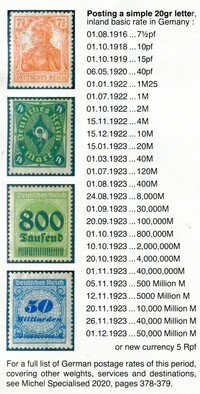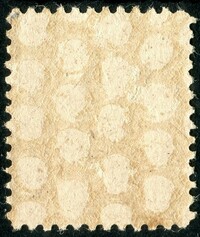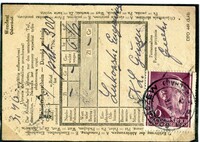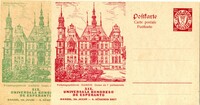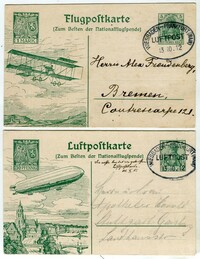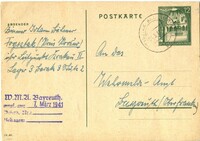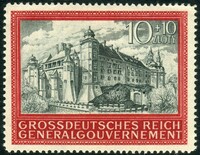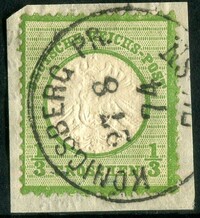Blogs on German Philately
These blogs cover aspects of building a German stamp and postal history collection. I hope to encourage your imagination! By the way, items given as examples, e.g. #026482, are our stock numbers, subject unsold, you can look them up on this web site. Just insert the six-digit number in the search box on our home page, and the item should spring up.
NUMERAL CANCELS ON GERMAN STATES STAMPS
- Published
- 16/01/24 07:22:00 AM
Various German states used numeral cancels on their earlier stamp issues.
There was normally one number for each post town, and initially number order from "1" matching alphabetical town order, but then adding extras at the end as needed, when the postal system expanded. It is a very collectable subject.
Click below and see which States stamps show numeral cancels, and how extensive were they?
1923 INFLATION (and UK 2023?)
- Published
- 13/10/23 10:30:00 AM
In WWI, German had initially advanced their frontiers on both fronts. They believed it was safe to borrow extensively for the war effort, as any war debts could be paid off by requisitioning conquered factories and assets. This proved to be a false hope.
Click n the link below to read more.
1945 CHAOS & ADVERSITY
- Published
- 07/10/23 05:07:00 AM
Germany officially surrendered 8 May 1945 and the borders of the four Zones were created by the Berlin Declaration of 5 June 1945.
The move from military occupation to civilian administration was patchy and slow.
Loss of territory : All territories occupied in WWII were no longer part of Germany, equally East Prussia became part of Poland or Russia. At one stage, 25% of the Russian Zone consisted of homeless refugees arriving from the East, returning from captivity, or expelled due to denazification processes in East Europe. Consequently, huge shortages of housing and essentials of life, especially in the Soviet Zone. This affected stamp production. (Read more by clicking below)
CONCENTRATION CAMPS
- Published
- 15/08/23 06:40:00 AM
From the estate of a local collector, we have been able to offer a superb range of camp mail covers, extending from before the war, through to the last days.
Camp mail is a dark subject, and it is obviously a case of respect and remembrance for those who died. In many cases we are able to record the names of inmate writers in the list descriptions.
Through mail of this era, we can understand the history of how camps came from small beginnings to reaching a final toll of millions of people from most nations of Europe.
From 1933 many Germans were arrested without fair trial and imprisoned in makeshift factories, camps or barracks. Mainly these were Communists, but included Social Democrats, priests and intellectuals. (Similar arrests in Stalin's Russia also dragged in philatelists, on account of their internationalist tendencies). In Germany, the guards were usually SA members, but after their purge, were replaced by SS in 1934.
The types of camps varied considerably. Covers, letter sheets and parcel cards show the diversity. For further explanation, and to see how these can form a postal history collection, click "read more" below.
A PLETHORA OF PLEBISCITES
- Published
- 19/05/23 07:04:00 AM
Germany's boundaries were always fluid, containing a good scattering of non-German speakers at the edges. The Versailles Congress of 1919 had a job on its hands. Plebiscites were to be held in the affected areas, with mapping, peace keeping and administration of the plebiscites in the hands of a thin international force. All would be fair and peaceful (?).
There were eight main territories to consider. For details and their history, read below.
THE GELBER HUND STORY
- Published
- 26/02/23 01:11:00 AM
At the end of 1906, the Hessen Royal family began planning a charity week in aid of needy mothers and children. In those days, infant mortality in Germany was around 20%, an issue of major national concern. More than five years of planning went into the event, the major attraction being to link the five major cities of the state (Offenbach, Frankfurt, Darmstadt, Worms and Mainz) into a circuit linked by airmail flights. 1912 was the big show. The public could now visit five airfields, buy special cards, and for a further airmail fee for a special stamp, they could actually send their cards on one of the flight links (with an additional Germania stamp for onward transmission). For more of the story, click below
1948 CURRENCY REFORM
- Published
- 18/09/22 11:32:00 AM
In the immediate aftermath of the war, old RM currency continued to be used, money was plentiful, but goods and housing much less so. This encouraged speculation, the black market, and led to fear of inflation as happened in 1923. Reform was needed, but was blocked by leaders in the Soviet Zone. In 1948 economic advisors in the British and American Zones took a unilateral step and created the new Deutsche Mark. But what to do with the stamps already printed and at post offices? (Click "Read more" below....)
HOW REGULAR ARE REGULAR STAMPS?
- Published
- 11/02/22 10:39:00 AM
For Germany and Austria, we keep a good stock of "regular" stamps up to about 1950. These are stamps listed in the main catalogues like Gibbons and Michel. But do our customers collect them is a "regular" way? (Click "Read more" below)
WAYS TO SPECIALISE IN WWII GERMAN PHILATELY
- Published
- 10/02/22 12:21:00 PM
There is technical philately and there is social philately. This blog looks at different ways of applying these skills to the stamps and postal history of the III Reich. Some of the items (e.g. #026377) are from our stock. You can view these (subject unsold) by inserting the six-digit stock number in the query box on our home page (top left) and the item should spring into view. (Click "Read more" below)
GERMANY 1930s, DARKENING CLOUDS
- Published
- 10/02/22 01:52:00 AM
This blog aims to match history with the stamps. President von Hindenburg, seen as the grand uncle and father figure of the nation, presided over a nation which, from the late 1920s until 1932, still balanced between socialism, democracy, nationalism, and SA gang rule at street level. But more was to follow.... (Click "Read more" below)
A JOURNEY CONTINUES (the 1920s)
- Published
- 08/09/21 10:16:00 AM
Inflation and recovery, Bauhaus and Zeppelins, in our Part 3 list. For an outline of the background and history, click "Read more" below.
SPECIALISING
- Published
- 19/06/21 12:24:00 PM
SPECIALISING....
There comes a point where a collection of regular stamps becomes virtually complete, but certain sectors have a special affection. This is the time when specialisation becomes an interesting and challenging way to continue the hobby. (Click "Read more" below)
If you are reading the second section of our Germany Part 2 list you have already begun. The stamps of Germany proper fall into three main groups for the period up to the end of WWI:
A JOURNEY
- Published
- 11/06/21 09:08:00 AM
Germany's journey from Unification (1871) and rapid industrialisation, to loss of the Colonial Empire, defeat in WWI and abdication of the Kaiser (1918) took less than a lifetime. What a fascinating story in European history, which can be told by stamps and postal history featured in our Part 2 list. (Click "Read more" below)
HOW MANY GERMAN STATES WERE THERE?
- Published
- 11/06/21 08:51:00 AM
Gibbons and Michel list sixteen states issuing postage stamps before the formation of the North German Confederation, plus Heligoland which was a British possession until 1890, and Alsace-Lorraine which was in military occupation from 1870. Like most things in history, the background was more complex. (Click "Read more" below)

